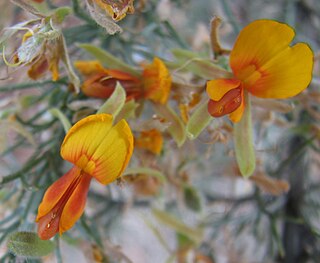
Jacksonia furcellata, commonly known as grey stinkwood, is a species of flowering plant in the family Fabaceae and is endemic to the south-west of Western Australia. It is a prostrate to low-lying, or weeping erect shrub with greyish-green branches, sharply-pointed side branches, its leaves reduced to scales leaves, yellowish-orange flowers, and woody, hairy pods.

Jacksonia sternbergiana, commonly known as stinkwood, is a species of flowering plant in the family Fabaceae and is endemic to the south-west of Western Australia. The Noongar peoples know the plant as kabbur, koorpa or mondurn. It is an erect or weeping shrub or tree with dull green branches, straight, sharply-pointed side branches, its leaves reduced to scales, yellowish-orange flowers, and woody, hairy pods.

Jacksonia anthoclada is a species of flowering plant in the family Fabaceae and is endemic to the south-west of Western Australia. It is an erect, single-stemmed shrub with hairy, elliptic to egg-shaped phylloclades with sharply-pointed edges, yellow-orange flowers with red markings, and hairy, woody pods.

Jacksonia aculeata is a species of flowering plant in the family Fabaceae and is endemic to the northern Australia. It is a spreading shrub with sharply-pointed, hairy, short side branches, leaves reduced to scales, lemon-yellow flowers, and woody, hairy pods.

Jacksonia angulata is a species of flowering plant in the family Fabaceae and is endemic to the south-west of Western Australia. It is a tufted, spreading to prostrate shrub often with zig-zagged branches, sharply-pointed side branches or phylloclades, leaves reduced to broadly egg-shaped scales, yellow-orange to orange flowers with a red "eye", and woody, densely hairy pods.

Jacksonia arenicola is a species of flowering plant in the family Fabaceae and is endemic to the south-west of Western Australia. It is an erect, broom-like shrub with densely hairy, sharply-pointed phylloclades, yellow-orange flowers with red markings, and woody pods that are hairy at first, later glabrous.
Jacksonia arnhemica is a species of flowering plant in the family Fabaceae and is endemic to the Northern Territory. It is an erect, densely branched, delicate shrub, the end branches sharply-pointed phylloclades, with yellow flowers, and woody, hairy pods.
Jacksonia calycina is a species of flowering plant in the family Fabaceae and is endemic to the south west of Western Australia. It is an erect or straggling shrub with sharply pointed end branches, yellow-orange flowers with red and yellow markings, and woody, hairy pods.
Jacksonia carduacea is a species of flowering plant in the family Fabaceae and is endemic to the south-west of Western Australia. It is a bushy shrub with its end-branches elliptic to egg-shaped phylloclades, and yellow-orange flowers in clusters in the axils of phylloclades.

Jacksonia condensata is a species of flowering plant in the family Fabaceae and is endemic to the south west of Western Australia. It is a slender, ascending to erect shrub with sharply-pointed phylloclades, the leaves reduced to scales, yellow to yellow-orange flowers, and woody, hairy pods.

Jacksonia cupulifera is a species of flowering plant in the family Fabaceae and is endemic to the north-west of Western Australia. It is an erect shrub or weeping tree with sharply-pointed phylloclades, its leaves reduced to scales and yellow-orange flowers scattered along the branches.

Jacksonia debilis is a species of flowering plant in the family Fabaceae and is endemic to the south west of Western Australia. It is a spreading to prostrate shrub with curved phylloclades, yellow-orange flowers with red markings, and woody, hairy pods.

Jacksonia dilatata is a species of flowering plant in the family Fabaceae and is endemic to the northern Australia. It is usually an erect shrub or small tree with narrowly egg-shaped phylloclades, the leaves reduced scales, and yellow flowers in clusters of up to 20 at the ends of the phylloclades.
Jacksonia divisa is a species of flowering plant in the family Fabaceae and is endemic to a restricted part of Kakadu National Park. It is an erect, densely branching shrub, its end branches flattened, hairy, leaf-like phylloclades, its leaves reduced to broadly lance-shaped scales, with yellow flowers, and woody, hairy pods.
Jacksonia effusa is a species of flowering plant in the family Fabaceae and is endemic to a restricted area near Nitmiluk (Katherine) Gorge. It is a sprawling shrub, its end branches sharply-pointed phylloclades, its leaves reduced to sharply-pointed, narrowly egg-shaped scales, its flowers pale yellow, and its fruit, woody, hairy pods.

Jacksonia elongata is a species of flowering plant in the family Fabaceae and is endemic to the south of Western Australia. It is an erect or spreading, spindly shrub with yellowish-green branches, yellow-orange flowers with red markings, and woody, densely-hairy pods.
Jacksonia epiphyllum is a species of flowering plant in the family Fabaceae and is endemic to the south of Western Australia. It is an erect or straggling shrub, the end branches egg-shaped or elliptic phylloclades, the leaves reduced to scale leaves, the flowers yellow-orange with red markings, and woody, densely-hairy pods.
Jacksonia eremodendron is a species of flowering plant in the family Fabaceae and is endemic to the south-west of Western Australia. It is a straggling shrub to small tree, the end branches egg-shaped, elliptic or oblong phylloclades with sharply-pointed teeth on the edges, the flowers yellow-orange with red markings and attached to teeth on phylloclades, and woody, densely-hairy pods.
Jacksonia flexuosa is a species of flowering plant in the family Fabaceae and is endemic to a restricted part of the Northern Territory. It is an erect, densely branching shrub, the end branches short, zig-zagged and scattered along the branches and densely hairy, the leaves reduced to sharply-pointed scale leaves, the flowers yellow, and the fruit is a woody, densely hairy pod.

Jacksonia floribunda, commonly known as holly pea, is a species of flowering plant in the family Fabaceae and is endemic to the south-west of Western Australia. It is a prostrate, low-lying, erect or upright shrub with egg-shaped, elliptic or oblong phylloclades with sharply-pointed lobes, leaves reduced to scales and yellow-orange flowers with red markings in long, dense clusters, with scale leaves at the base.












